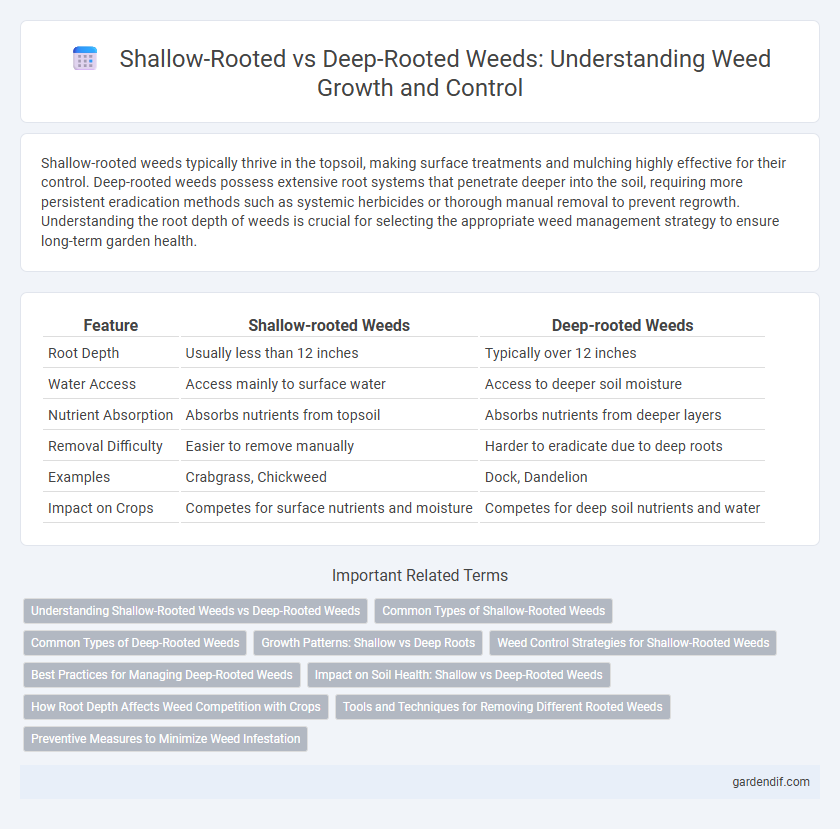
Shallow-rooted weeds vs deep-rooted weeds Illustration
Shallow-rooted weeds typically thrive in the topsoil, making surface treatments and mulching highly effective for their control. Deep-rooted weeds possess extensive root systems that penetrate deeper into the soil, requiring more persistent eradication methods such as systemic herbicides or thorough manual removal to prevent regrowth. Understanding the root depth of weeds is crucial for selecting the appropriate weed management strategy to ensure long-term garden health.
Table of Comparison
| Feature | Shallow-rooted Weeds | Deep-rooted Weeds |
|---|---|---|
| Root Depth | Usually less than 12 inches | Typically over 12 inches |
| Water Access | Access mainly to surface water | Access to deeper soil moisture |
| Nutrient Absorption | Absorbs nutrients from topsoil | Absorbs nutrients from deeper layers |
| Removal Difficulty | Easier to remove manually | Harder to eradicate due to deep roots |
| Examples | Crabgrass, Chickweed | Dock, Dandelion |
| Impact on Crops | Competes for surface nutrients and moisture | Competes for deep soil nutrients and water |
Understanding Shallow-Rooted Weeds vs Deep-Rooted Weeds
Shallow-rooted weeds, such as chickweed and spurge, thrive near the soil surface with roots that typically extend only a few inches, making them easier to remove and control by surface cultivation or mulching. Deep-rooted weeds like dandelions and bindweed penetrate several feet into the soil, requiring more intensive methods such as deep digging or targeted herbicides to eradiate their extensive root systems. Recognizing the root depth is crucial for effective weed management strategies that prevent regrowth and protect crop health.
Common Types of Shallow-Rooted Weeds
Common types of shallow-rooted weeds include chickweed, crabgrass, and purslane, which thrive in nutrient-rich, moist soils and reproduce rapidly through seeds and shallow root systems. These weeds are often easier to manage with surface-level cultivation or mulching, as their roots rarely penetrate deeper than a few inches. Understanding the growth patterns of shallow-rooted weeds aids in selecting effective control measures such as targeted herbicides and manual removal to prevent their spread in gardens and lawns.
Common Types of Deep-Rooted Weeds
Deep-rooted weeds such as dock, dandelion, and thistle pose significant challenges due to their extensive root systems that penetrate soil deeply, making removal difficult. These weeds store nutrients in their taproots, allowing them to regrow quickly after surface-level treatments. Effective management often requires targeted herbicides or mechanical removal methods that reach below the soil surface to disrupt their root structure.
Growth Patterns: Shallow vs Deep Roots
Shallow-rooted weeds typically develop extensive horizontal root systems close to the soil surface, allowing rapid absorption of surface moisture and nutrients but making them vulnerable to surface disruption. Deep-rooted weeds grow vertical root systems that penetrate far into the soil, accessing water and nutrients from deeper layers and exhibiting greater resilience during drought conditions. Understanding these differing growth patterns helps target control methods, as shallow-rooted weeds respond well to surface treatments while deep-rooted weeds require systemic approaches.
Weed Control Strategies for Shallow-Rooted Weeds
Shallow-rooted weeds, such as chickweed and crabgrass, can be effectively managed through surface-level interventions like mulching and frequent shallow cultivation to disrupt root establishment. Applying pre-emergent herbicides targets these weeds before germination, while timely post-emergent treatments help control young seedlings without affecting deeper-rooted plants. Integrating cultural practices, such as maintaining dense turfgrass cover, reduces soil exposure and limits shallow-rooted weed proliferation.
Best Practices for Managing Deep-Rooted Weeds
Deep-rooted weeds require targeted management techniques such as deep tillage and the application of systemic herbicides that penetrate the root zone, ensuring thorough eradication. Cultivating soil regularly to disrupt root development combined with crop rotation can reduce the resilience of perennial deep-rooted weed species. Integrating mechanical removal with chemical controls enhances long-term weed suppression, preventing regrowth from root fragments.
Impact on Soil Health: Shallow vs Deep-Rooted Weeds
Shallow-rooted weeds disrupt the upper soil layers, causing nutrient depletion and increased erosion risk, thereby reducing topsoil fertility and structure. Deep-rooted weeds penetrate and break compacted soil layers, enhancing aeration and water infiltration but can also deplete deep soil moisture and essential nutrients. The balance between these weed types influences soil health by affecting nutrient cycling, soil stability, and microbial activity.
How Root Depth Affects Weed Competition with Crops
Shallow-rooted weeds primarily compete with crops for nutrients and moisture in the upper soil layers, often causing significant stress during early crop growth stages. Deep-rooted weeds access water and nutrients from deeper soil profiles, maintaining competition even during dry conditions and reducing crop resilience. Understanding root depth helps in selecting appropriate weed management strategies, such as targeted herbicide application or cultivation practices, to minimize crop yield losses.
Tools and Techniques for Removing Different Rooted Weeds
Shallow-rooted weeds can be effectively removed with hand tools like hoes and weed pullers that disrupt roots near the soil surface, minimizing regrowth. Deep-rooted weeds require more specialized equipment such as digging forks or root extractors to reach and remove the entire root system, preventing underground runners from spreading. Chemical treatments with systemic herbicides complement mechanical removal by targeting deep root structures, ensuring comprehensive weed control.
Preventive Measures to Minimize Weed Infestation
Shallow-rooted weeds can be effectively managed by regular surface cultivation and mulching, which disrupt their growth and reduce seed germination. Deep-rooted weeds require targeted measures such as deep tillage and use of systemic herbicides to control their extensive root systems. Implementing crop rotation and maintaining healthy soil conditions help prevent both weed types from establishing and spreading.
Shallow-rooted weeds vs deep-rooted weeds Infographic

 gardendif.com
gardendif.com